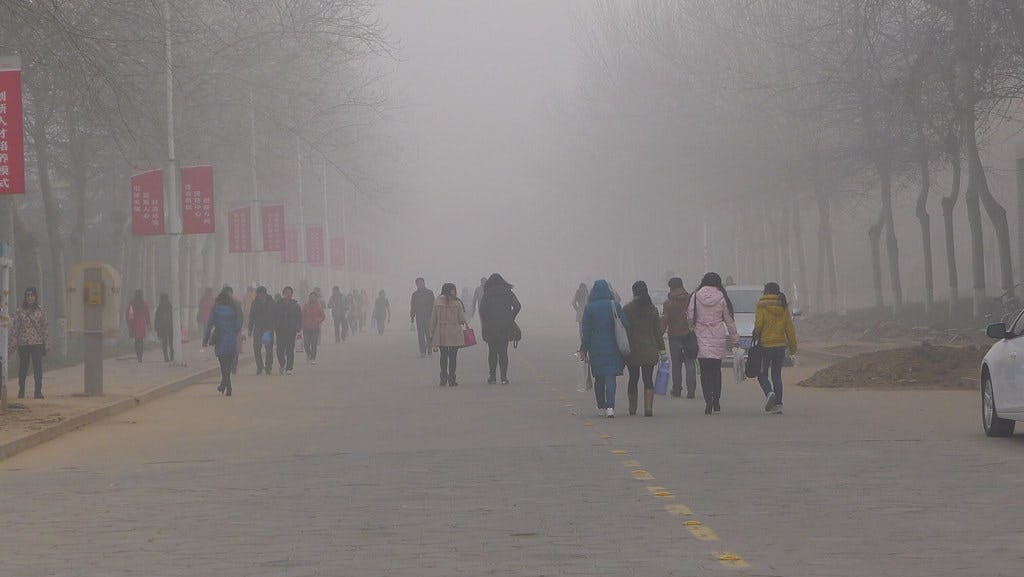Reducing China’s Black Carbon Emissions: An Arctic Dimension

Chinese university students come and go in the dense air pollution. Photo: vtpoly
China’s Arctic engagement has increased considerably during the past decade, which has not only offered plentiful economic opportunities but also created new risks and concerns among the eight Arctic states, non-state actors, and peoples. To increase understanding of dimensions of Beijing’s Arctic activities, The Arctic Institute’s China Series 2020 probes into China’s evolving Arctic interests, policies, and strategies, and analyses their ramifications for the region (and beyond).
The Arctic Institute China Series 2020
- China and its Arctic Trajectories: The Arctic Institute’s China Series 2020
- The tortuous path of China’s win-win strategy in Greenland
- Defining the Chinese Threat in the Arctic
- Reducing China’s Black Carbon Emissions: An Arctic Dimension
- Identity and Relationship-Building in China’s Arctic Diplomacy
- A Framework for Sino-Russian Relations in the Arctic
- The Emergence of a Sino-Russian Economic Partnership in the Arctic?
- Arctic Technopolitics and China’s Reception of the Polar Code
- ‘Prepared to Go Fully Kinetic’: How U.S. Leaders Conceptualize China’s Threat to Arctic Security
- China and its Arctic Trajectories: Final Remarks
Black carbon emissions (soot) reduction is critical for global climate, air quality and human health. Black carbon is the second most important individual climate-warming agent after carbon dioxide (CO2), and it also contributes to air pollution as a component of fine particulate matter (PM2.5). Research suggests that black carbon has played a significant role in the recent warming in the Arctic: this includes emissions from countries outside the region, particularly in Asia.
China’s black carbon emissions are significant on a global scale: its contribution accounted for 20 to 24% of the global total – the highest proportion – during the period from 1990 to 2007. China’s emissions of black carbon mainly originate from using biomass, coal or oil for cooking and heating in residential and industrial sectors, diesel transportation, and open agricultural burning. These emissions were steadily declining in 2010-2017; however, the 2019 data shows an increase of coal consumption of 3.3 per cent from the previous year, which points to a possible increase in associated black carbon emissions. This emissions data implies that any measures China adopts to limit its black carbon emissions have a significant impact on the global climate and the Arctic.
Globally, attention to black carbon emissions is on the rise with cooperative efforts concentrating under Climate and Clean Air Coalition (CCAC) and the Arctic Council. The CCAC is a voluntary government-led partnership with the goal of raising awareness and improving scientific understanding of short-lived climate pollutants (including black carbon), building capacities, strengthening national and regional actions, and promoting best practices. The Arctic Council has been proactive in addressing black carbon emissions not only among its member states but also among observer states. For non-Arctic states, the Council aims to raise awareness and encourage participation in the development and improvement of emissions inventories. In addition, under the Paris Agreement several countries have mentioned reducing black carbon emissions in their Nationally Determined Contributions.
China’s engagement in these initiatives has been low so far. Its relatively passive attitude towards global cooperation efforts on black carbon can be partly explained by the immaturity of its domestic discussion and policy approach to the issue. There has been limited attention on the part of policy-makers to black carbon emissions.
The main challenge for the country is insufficient data on black carbon emissions and limited understanding of their sources, impacts, and mitigation pathways. Consequently, there are no policies in China specifically targeting these emissions. At the same time, black carbon is indirectly addressed through targets for reducing emissions of PM2.5 which have been successful in dramatically improving air quality in the key cities in China. Synergies between air quality and climate policy goals are also acknowledged in recent policies, for instance in the new Three-Year Action Plan for Winning the Blue Sky War (2018–2020). However, in general air pollution policies lack a black carbon focus.
The same holds for China’s climate policies. China’s domestic policy has primarily focused on CO2 emissions and its Nationally Determined Contribution under the Paris Agreement includes only CO2 emissions reduction targets. In principle, as CO2 and black carbon are often co-emitted by the same sources, measures to reduce CO2 emissions lead to reductions in black carbon emissions; yet, the degree of such reductions is unclear.
Therefore, black carbon emissions have not yet received sustained policy attention in China. This represents a lost opportunity to realize significant co-benefits from tackling these emissions for climate, air quality and human health. With improving emissions inventories, strengthening science-policy interface and the recent transfer of the climate change policy portfolio to the Ministry of Ecology and Environment, there is a high potential to increase synergies between climate and air quality policy portfolios.
What does this mean for the global community? Active cooperation on the science, and emissions monitoring and inventories as well as knowledge sharing about possible solutions should be the focus of current dialogues with China. These can take place both bilaterally and under international or global fora such as CCAC, UN Climate Change Convention and Arctic Council. Reducing black carbon emissions is a promising area of cooperation because emissions reductions carry immediate benefits both for the world at large and for China.
Yulia Yamineva, PhD, Associate Professor at the Law School, Faculty of Social Sciences and Business Studies, University of Eastern Finland.